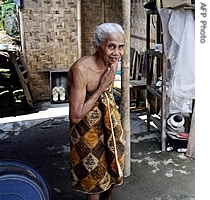2007年VOA标准英语-Indonesian Earthquake Survivors Struggling Afte
搜索关注在线英语听力室公众号:tingroom,领取免费英语资料大礼包。
(单词翻译)
By Chad BouchardYogyakarta, Indonesia
24 May 2007
One year after a massive earthquake struck Indonesia's Java island, thousands of people hit hardest by the disaster still struggle to rebuild their lives. As Chad Bouchard reports from Yogyakarta, aid workers have turned their attention from emergency needs to work programs for the most vulnerable groups.
 |
| An elderly woman stands next to her temporary shelter nearly one year after an earthquake shuttered the region, 20 May 2007 |
During the first months of recovery, local and international agencies churned out tens of thousands of shelters to house more than 1.5 million people left homeless.
Government officials say less than 10,000 people in remote areas remain without adequate shelter.
Phil Vine with the International Federation1 of Red Cross Agencies says the housing operation here is a model for disaster response. The Red Cross set up small teams to build houses out of local material, such as bamboo, that is cheap, easy to use and earthquake resistant2.
"What has happened here in the Yogyakarta earthquake has been seen globally as a benchmark for recovery using local materials in a low-cost way, in which the people themselves, based on the Javanese tradition of helping3 each other, just put these things up and rebuilt their lives in three months," Vine said.
But aid workers say as survivors4 focused on shelter and other immediate5 needs following the disaster, critical long-term sources of income were neglected.
Hadiwiyono, a farmer from the Mutihan Village in the hard-hit Klaten district, stands ankle deep in a rice paddy, tending neat green rows of shoots. The 57-year-old mother of five is one among thousands of farmers who lost their homes in the quake. During last fall's growing season, fields like this one were left fallow and choked with weeds.
Many farmers lost an entire planting cycle, and the fall crop was about 40 percent below normal.
Hadiwiyono says she left the fields behind because she had to work on her collapsed6 house. She says the first months after the quake were chaotic7, but with some fertilizer and seed donations from the Food and Agriculture Organization she is able to go back to her life as a rice farmer.
FAO officials say 132 farmers have received seed and fertilizer help, but harvests remain below normal. The program will expand to help more people.
Challenges also remain for more than 1,000 people who suffered debilitating8 spinal9 injuries in the quake. Health care workers say many of those left with limited mobility10 have suffered severe depression. Dozens have attempted suicide.
Tatur Prianto is a Red Cross volunteer and an amateur radio hobbyist. He decided11 to connect secluded12 patients over a radio network.
Prianto says two religious programs and one counseling show are broadcast each day, and participants can talk about their lives and connect with other severely13 injured survivors. He says they usually share experiences on how to cope with their disabilities, or how to sell flowers and other small business ideas. Sometimes they even talk about sex. He adds that he wants to see the program include more disabled people.
Phil Vine says the Red Cross will likely employ this model during future disasters.
"I can only see it expanding. I mean it is just one of those smart ideas. There is a lot of counseling that goes on, and there is a lot of flirting14 that goes on," he said. "One of them is a budding romance between this 23-year-old who had a spinal injury, totally lost the use of her legs, and she is hooked up with one of the Indonesian ambulance drivers. And they are engaged to be married."
The International Organization for Migration15 and other agencies have stepped in to provide handicap-accessible housing and job opportunities for the disabled.
Purniewen is the livelihood16 assistance coordinator17 for the U.N. Development Program in Yogyakarta. He says relief agencies learned important lessons from previous disasters in Indonesia, such as the Indian Ocean tsunami18 in the country's Aceh province, where about 160,000 people died.
He says aid groups have learned to take advantage of community ties - with neighbors volunteering to help rebuild each other's homes. He says that helped get people back to their jobs so they could provide for their families.
"One lesson is actually that social capital is quite important in terms of fostering the recovery," he said. "Yogya has very strong social capital. Eighty percent of people are already working - not recovered, but already work again. That is an indication that social capital played a role important in this case."
The U.N. and other agencies have revived small traditional industries such as pottery19, weaving, and furniture production for more than 4,000 households.
Aid workers say while thousands more still need assistance, restoring livelihoods20 is the only way to leave behind a self-reliant community.
 收听单词发音
收听单词发音 




